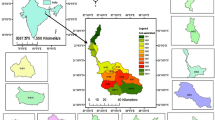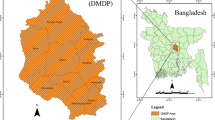Abstract
Knowledge of soil texture variations is critical for agricultural and engineering applications because texture influences many other soil properties. This study used random forest method to evaluate the effects of human activities and topographic parameters on the spatial variability of soil texture in hilly areas where soil parent material was uniform. The study site covers 252 km2 and is located in the Upper Yangtze River Basin of south-west China. A total of 3636 samples were collected from the cultivated soils at a depth of 20 cm of dryland (sloping field and terraced land) landscape. The soil texture class for each sample was estimated by experienced soil scientists in the field. Two soil texture classes (loam and clay) were observed in the watershed. Eleven terrain parameters were derived from a digital elevation model with a resolution of 30 m. Compared with loamy soils, clayey soils were mostly observed in the areas with lower elevation and gentle slopes. The outcome of random forest indicated that human activities and elevation had strong effects on soil texture class variations across the study site. Further results showed that the relative importance of terrain parameters to soil texture class variations varied with dryland landscape. Topographic wetness index and elevation were the most important variables for sloping field and terraced land landscapes, respectively.






Similar content being viewed by others
References
Ampontuah, E. O., Robinson, J. S., & Nortcliff, S. (2006). Assessment of soil particle redistribution on two contrasting cultivated hillslopes. Geoderma, 132, 324–343.
Breiman, L. (2001). Random forests. Machine Learning, 45, 5–32.
Breiman, L., Culter, A. (2003). Manual on setting up, using, and understanding randomForests V4.0.
Ceddia, M. B., Vieira, S. R., Villela, A. L. O., Mota, L. D. S., Anios, L. H. C. D., & Carvalho, D. F. (2009). Topography and spatial variability of soil physical properties. Scientia Agricola (Piracicaba, Brazil), 66(3), 338–352.
Chagas, C. S., Junior, W. C., Bhering, S. B., & Filho, B. C. (2016). Spatial prediction of soil surface texture in a semiarid region using random forest and multiple linear regressions. Catena, 139, 232–240.
FAO (2006). Guidelines for soil description. Rome, Italy.
Florinsky, I. V., Eilers, R. G., Manning, G. R., & Fuller, L. G. (2002). Prediction of soil properties by digital terrain modeling. Environmental Modelling & Software, 17, 295–311.
Foss, J. E., Wright, W. R., & Coles, R. H. (1975). Testing the accuracy of field textures. Soil Science Society of America, Proceeding, 39, 800–802.
Gessler, P. E., Chadwick, O. A., Chamran, F., Althouse, L., & Holmes, K. (2000). Modeling soil-landscape and ecosystem properties using terrain attributes. Soil Science Society of America Journal, 64, 2046–2056.
Gobin, A., Campling, P., & Feyen, J. (2001). Soil-landscape modeling to quantify spatial variability of soil texture. Physics and Chemistry of the Earth (B), 26, 41–45.
Gong, Z. T. (1999). Chinese soil taxonomy. Beijing: Science Press.
Govers, G., Quine, T. A., Desmet, P. J. J., & Walling, D. E. (1996). The relative contribution of soil tillage and overland flow erosion to soil redistribution on agricultural land. Earth Surface Processes and Landforms, 21, 929–946.
Grimm, R., Behrens, T., Märker, M., & Elsenbeer, H. (2008). Soil organic carbon concentrations and stocks on Barro Colarado Island-digital soil mapping using random forests analysis. Geoderma, 146, 102–113.
Guo, P. T., Li, M. F., Luo, W., Tang, Q. F., Liu, Z. W., & Lin, Z. M. (2015). Digital mapping of soil organic matter for rubber plantation at regional scale: an application of random forest plus residuals kriging approach. Geoderma, 237, 49–59.
Heckrath, G., Djurhuus, J., Quine, T. A., Van Oost, K., Govers, G., & Zhang, Y. (2005). Tillage erosion and its effect on soil properties and crop yield in Denmark. Journal of Environmental Quality, 34, 312–323.
Landrum, C., Castrignano, A., Mueller, T., Zourarakis, D., Zhu, J. F., & Benedetto, D. D. (2014). An approach for delineating homogenous within-field zones using proximal sensing and multivariate geostatistics. Agricultural Water Management, 147, 144–153.
Liaw, A., & Wiener, M. (2002). Classification and regression by random Forest. R News, 2, 18–22.
Ließ, M., Glaser, B., & Huwe, B. (2012). Uncertainty in the spatial prediction of soil texture—comparison of regression tree and random forest models. Geoderma, 170, 70–79.
Lobb, D. A., Kachanoski, R. G., & Miller, M. H. (1995). Tillage translocation and tillage erosion on shoulder slope landscape positons measured using Cs-137 as a tracer. Canadian Journal of Soil Science, 75, 211–218.
Montgomery, D., Peck, E., & Vining, G. (2001). Introduction to linear regression analysis (3rd ed.). New York: Wiley.
Moore, I. D., Gessler, P. E., Nielsen, G. A., & Peterson, G. A. (1993). Soil attribute prediction using terrain analysis. Soil Science Society of America Journal, 57, 443–452.
Obi, J. C., Ogban, P. I., Ituen, U. J., & Udoh, B. T. (2014). Development of pedotransfer functions for coastal plain soils using terrain attributes. Catena, 123, 252–262.
de Oliveira, J.F., Mayi III, S., Marchão, R.L., Corazza, E.J., Hurtado, S.M. C., Guimarães, M. (2011). Homogenous areas and available water content of a yellow-red Latosoil. In: Inamasu, R.Y., Naime, J., de Resende, A.V., Bassoi, L.H., Bernardi, A.C. (eds.): Agricultura de Precisão: Um Novo Olhar. Embrapa, Brasilia. pp. 143–147 (in Portuguese).
Pachepsky, Y. A., Rawls, W. J., & Lin, H. S. (2006). Hydropedology and pedotransfer functions. Geoderma, 131, 308–316.
Post, D. F., Huete, A. R., & Pease, D. S. (1986). A comparison of soil scientist estimations and laboratory determinations of soil Arizona soil properties. Journal of Soil and Water Conservation, 41, 421–424.
R Core Team (2015). R: A language and environment for statistical computing. R Foundation for Statistical Computing, Vienna, Austria. URL http://www.R-project.org/.
Ramos, M. C., Cots-Folch, R., & Martínez-Casasnovas. (2007). Effects of land terracing on soil properties in the Priorat region in northeastern Spain: A multivariate approach. Geoderma, 142, 251–261.
Sponagel, H., Grottenthaler, W., Hartmann, K. J., Hartwich, R., Janetzko, P., Joisten, H., Kűhn, D., Sabel, K. J., & Traidl, R. (Eds.). (2005). Bodenkundliche Kartieranleitung (German Manual of Soil Mapping, KA5) (fifth ed.). Hannover: Bundesanstalt fűr Geowissenschaften und Rohstoffe.
Stępień, M., Samborski, S., Gozdowski, D., Dobers, E. S., Chormański, J., & Szatylowicz, J. (2015). Assessment of soil texture class on agricultural fields using ECa, amber NDVI, and topographic properties. Journal of Plant Nutrition and Soil Science, 2015(178), 523–536.
Tajik, S., Ayoubi, S., & Nourbakhsh, F. (2012). Prediction of soil enzymes activity by digital terrain analysis: comparing artificial neural network and multiple linear regression models. Environmental Engineering Science, 29, 798–806.
Tang, J. L., Cheng, X. Q., Zhu, B., Gao, M. R., Wang, T., Zhang, X. F., Zhao, P., & You, X. (2015). Rainfall and tillage impacts on soil erosion of sloping cropland with subtropical monsoon climate-a case study in hilly purple soil area, China. Journal of Mountain Science, 12(1), 134–144.
Thien, S. J. (1979). A flow diagram for teaching texture-by-feel analysis. Journal of Agronomic Education. Volume, 8, 54–55.
Urricariet, S., Niborski, M., & Kvolek, C. M. (2011). Soil attributes associated to corn yield variability in the sandy pampas. Ciencias del suelo, 29, 49–59 (in Spanish with English abstract).
Van Oost, K., Govers, G., & Van Muysen, W. (2003). A process-based conversion model for caesium-137 derived erosion rates on agricultural land: an integrated spatial approach. Earth Surface Processes and Landforms, 28, 187–207.
Viscara Rossel, R. A., & Behrens, T. (2010). Using data mining to model and interpret soil diffuse reflectance spectra. Geoderma, 158(1–2), 46–54.
Vos, C., Don, A., Prietz, R., Heidkamp, A., & Freibauer, A. (2016). Field-based soil-texture estimates could replace laboratory analysis. Geoderma, 267, 215–219.
Wiesmeier, M., Barthold, F., Blank, B., & Kőgel-Knabner, I. (2011). Digital mapping of soil organic matter stocks using random forest modeling in a semi-arid steppe ecosystem. Plant and Soil, 340, 7–24.
Wilcke, W., Yasin, S., Schmitt, A., Valarezo, C., & Zech, W. (2008). Soils along the altitudinal transect and in catchments. In Ecological studies 198, gradients in a Tropical Mountain ecosystem of Ecuador, chapter 9. Berlin Heidelberg: Springer.
Wu, W., Fan, Y., Wang, Z. Y., & Liu, H. B. (2008). Assessing effects of digital elevation model resolution on soil-landscape correlations in a hilly area. Agriculture, Ecosystems & Environment, 126, 209–216.
Zhang, J. H., Wang, Y., & Zhang, Z. H. (2014). Effect of terrace forms on water and tillage erosion on a hilly landscape in the Yangtze River basin, China. Geomorphology, 216, 114–124.
Author information
Authors and Affiliations
Corresponding author
Rights and permissions
About this article
Cite this article
Li, AD., Guo, PT., Wu, W. et al. Impacts of terrain attributes and human activities on soil texture class variations in hilly areas, south-west China. Environ Monit Assess 189, 281 (2017). https://doi.org/10.1007/s10661-017-5997-0
Received:
Accepted:
Published:
DOI: https://doi.org/10.1007/s10661-017-5997-0




